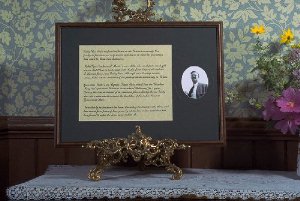
Carr house was designed by Architects Wright and Saunders, two of the earliest prominent architects in Victoria. They specialized in "high Victorian" style, and designed Carr house in the very beginning of their partnership. To the original plan the Carr family made minor changes and additions to the structure over many years while it was still their home.
The death of Elizabeth Carr ended the Carr family's residency of the house. About two years later, in February 1938, it was sold to Lena Godfrey. Very soon after, a fire damaged the back of the house, and many more modern changes were made to the structure and appearance of both the interior and exterior. During Godfrey's possession and later William Atema, the house was rented as 12 individual rooms.
 Carr house was saved from its destruction in April of 1964, being purchased by a Local Member of Parliament, David Groos. In the sitting room is a picture of Groos with a tribute, as seen on the right. The Emily Carr Foundation, created in 1967 by the Junior Chamber of Commerce, and the Federal Government were willing to share the cost of restoring the house.
Carr house was saved from its destruction in April of 1964, being purchased by a Local Member of Parliament, David Groos. In the sitting room is a picture of Groos with a tribute, as seen on the right. The Emily Carr Foundation, created in 1967 by the Junior Chamber of Commerce, and the Federal Government were willing to share the cost of restoring the house.
 A restoration architect named Peter Cotton, whose photograph can be seen to the left, began the restoration, but funds for the project dwindled. The house was subsequently transferred to the Province of British Columbia and designated a Provincial Historic Site in 1976. Beginning in the 1980's, Heritage Properties, with the help of consultant Stuart Stark, began research on the next phase of this project. Small additions to the decor of the house have been made periodically up to present day.
A restoration architect named Peter Cotton, whose photograph can be seen to the left, began the restoration, but funds for the project dwindled. The house was subsequently transferred to the Province of British Columbia and designated a Provincial Historic Site in 1976. Beginning in the 1980's, Heritage Properties, with the help of consultant Stuart Stark, began research on the next phase of this project. Small additions to the decor of the house have been made periodically up to present day.
 Return to Restoration main page.
Return to Restoration main page.

Last updated: 22 July 1997
Sponsored by: Industry Canada 
Produced by: Schoolnet Digital Collections Team
Content provided by: BC Heritage Branch, Province of British Columbia
 Carr house was saved from its destruction in April of 1964, being purchased by a Local Member of Parliament, David Groos. In the sitting room is a picture of Groos with a tribute, as seen on the right. The Emily Carr Foundation, created in 1967 by the Junior Chamber of Commerce, and the Federal Government were willing to share the cost of restoring the house.
Carr house was saved from its destruction in April of 1964, being purchased by a Local Member of Parliament, David Groos. In the sitting room is a picture of Groos with a tribute, as seen on the right. The Emily Carr Foundation, created in 1967 by the Junior Chamber of Commerce, and the Federal Government were willing to share the cost of restoring the house.

 A restoration architect named Peter Cotton, whose photograph can be seen to the left, began the restoration, but funds for the project dwindled. The house was subsequently transferred to the Province of British Columbia and designated a Provincial Historic Site in 1976.
A restoration architect named Peter Cotton, whose photograph can be seen to the left, began the restoration, but funds for the project dwindled. The house was subsequently transferred to the Province of British Columbia and designated a Provincial Historic Site in 1976. 





